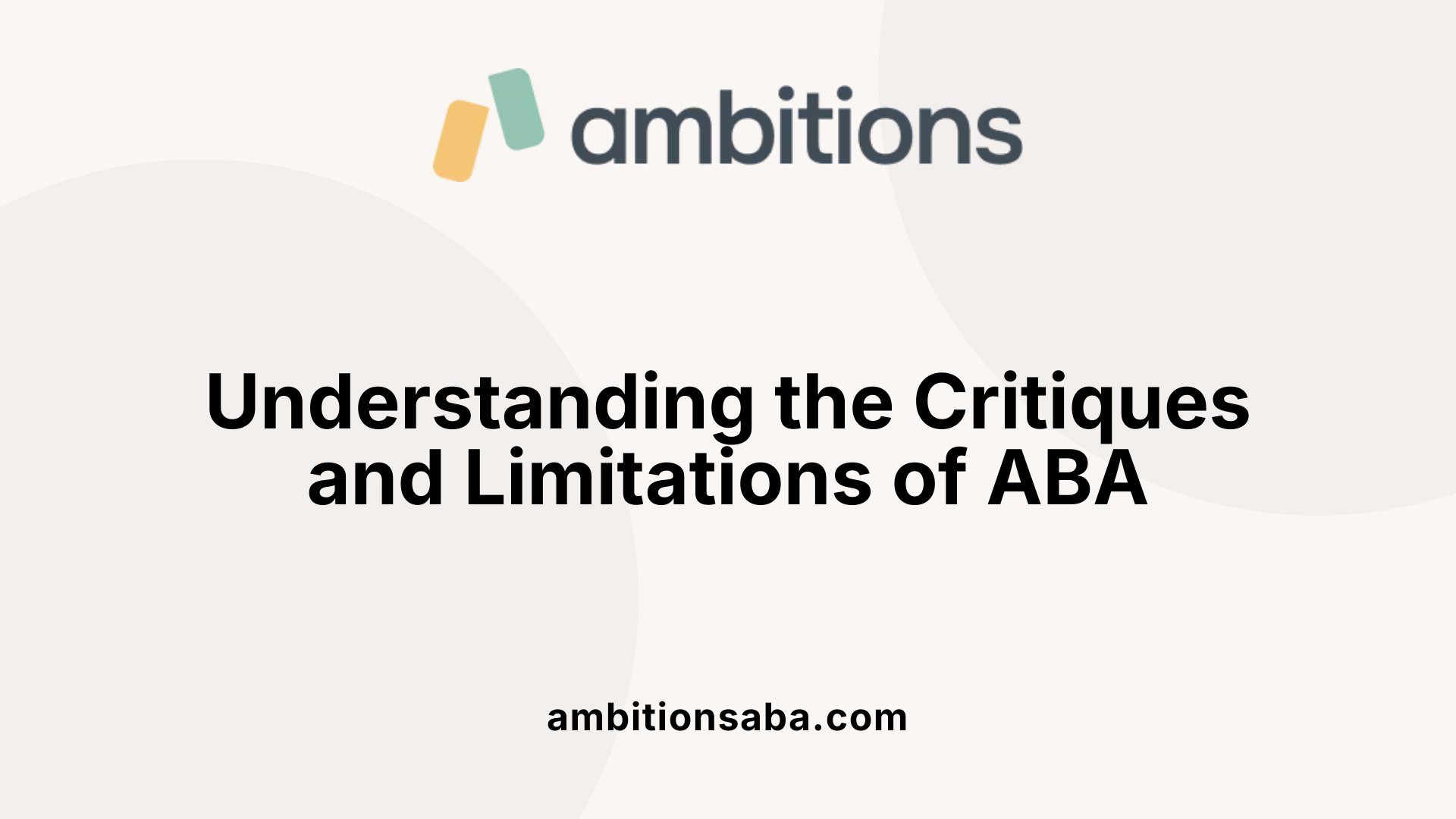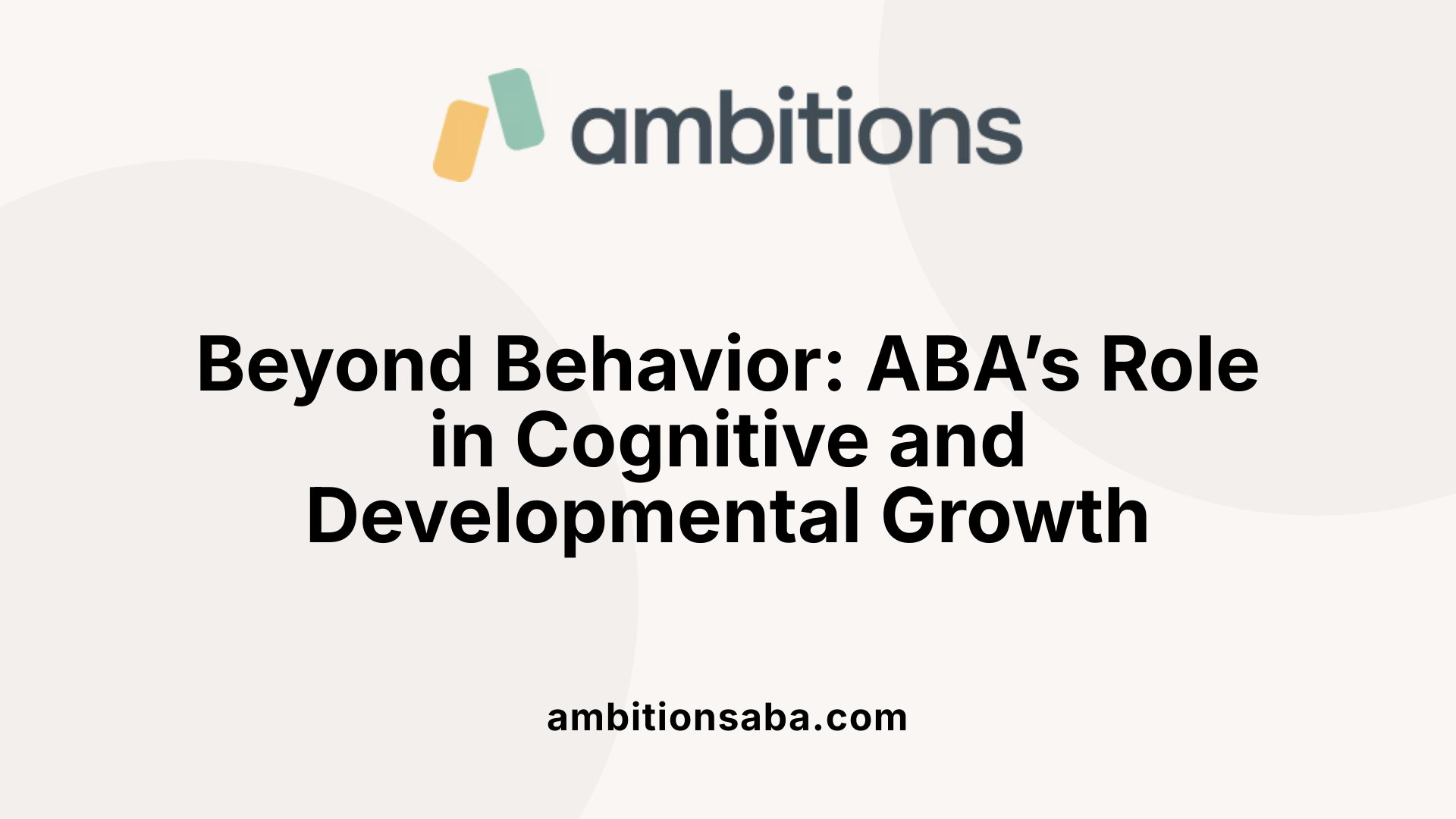Introduction to ABA and Its Role in Autism Support
Applied Behavior Analysis (ABA) therapy represents a cornerstone in the support and development of children with autism spectrum disorders (ASD). Rooted in behavioral science, ABA employs evidence-based techniques to foster meaningful improvements in abstract thinking, social skills, adaptive behaviors, and communication, helping children adapt and thrive in diverse environments.
Understanding Applied Behavior Analysis (ABA) Therapy
What is applied behavior analysis (ABA) therapy?
Applied Behavior Analysis (ABA) therapy is a scientific, evidence-based approach aimed at understanding and modifying behavior. It uses core behavioral principles to assess individual needs, set targeted goals, and apply techniques designed to increase positive behaviors and reduce those that may interfere with learning or social functioning.
Principles of learning and behavior in ABA
ABA is rooted in behaviorist theories, especially those of B.F. Skinner. It relies heavily on the concepts of reinforcement — increasing behaviors by providing positive consequences — prompting, and shaping (gradually modifying behaviors to approach the desired outcome).
Techniques used such as reinforcement, prompting, shaping
Common ABA techniques include:
- Positive reinforcement: rewarding desired behaviors to encourage repetition.
- Prompting: providing cues or assistance to elicit target behaviors.
- Shaping: reinforcing successive approximations of a complex behavior. Structured approaches like Discrete Trial Training (DTT) break down skills into small, teachable units, whereas naturalistic methods like Pivotal Response Treatment (PRT) promote learning through natural interactions.
Structured and naturalistic methods
ABA therapy employs a mix of highly structured interventions and more naturalistic, play-based models. This blend allows for intensive skill acquisition alongside practical application in real-life situations.
Settings and data collection
Therapy is delivered across multiple settings including one-on-one sessions, group activities, home, and school environments. Data is continuously collected to measure progress, guide decision-making, and adjust teaching strategies.
ABA’s ethical and individualized treatment aspects
ABA programs are tailored to each child's unique strengths and challenges, ensuring personalized and ethical care. Professional oversight from certified behavior analysts maintains fidelity to treatment plans and safeguards the child’s welfare.
This comprehensive approach enables ABA to support meaningful improvements in communication, social interactions, and adaptive behaviors for children with autism and other developmental challenges.
ABA Therapy’s Application in Autism Support
How is ABA therapy used to support individuals with autism?
Applied Behavioral Analysis (ABA) therapy is a structured, evidence-based approach designed to help individuals with autism spectrum disorder (ASD) by modifying behaviors through learning principles. It relies on the ABC framework — identifying the Antecedents (triggers), Behaviors, and Consequences — to understand and shape behavior patterns. This method uses positive reinforcement to encourage helpful behaviors while reducing challenging ones.
ABA therapies focus on developing essential skills across several areas, including communication, social interaction, daily living, and academics. For example, therapists may employ Discrete Trial Training (DTT), a highly structured technique that breaks down tasks into small, manageable steps with clear reinforcement. Complementing this are more naturalistic approaches like Pivotal Response Treatment (PRT), which encourages learning in more fluid, real-world contexts.
These interventions are highly individualized and intensive, often involving one-to-one tutoring sessions. Therapy can be delivered in multiple settings — at home, in schools, or community environments — depending on the needs of the child. Data collection and continuous progress monitoring ensure that the intervention adapts over time, optimizing outcomes.
Early and comprehensive ABA therapy has been demonstrated to significantly improve cognitive abilities, language skills, social interactions, and adaptive daily functioning in children with ASD. Intensive programs, frequently involving 20 to 40 hours per week, better equip individuals to navigate their surroundings, enhance independence, and improve overall quality of life.
Who Provides ABA Therapy and Their Qualifications
Professionals Delivering ABA Therapy
ABA therapy is typically provided by a range of professionals, primarily Board Certified Behavior Analysts (BCBAs), licensed therapists, and specialists trained in behavioral analysis and autism support. These individuals play a central role in delivering personalized interventions aimed at improving functional skills in children with autism spectrum disorders.
Qualifications of ABA Therapists
To become a qualified ABA therapist, individuals usually start with an undergraduate degree in psychology, education, or a related discipline. They then pursue a master's degree focusing on applied behavior analysis or an equivalent field. This academic background provides the foundation necessary to understand and apply behaviorist principles effectively within clinical and educational settings.
BCBA Certification Requirements
Earning BCBA certification is a crucial step for many ABA therapists. This process includes acquiring between 1,500 and 2,000 hours of supervised field experience, which ensures practical competence. Candidates must also pass a comprehensive credential examination that rigorously tests their knowledge and skills. Certification is vital for demonstrating a therapist’s expertise and commitment to evidence-based ABA practices.
Licensure and Supervised Experience
In addition to BCBA certification, many U.S. states require ABA therapists to obtain licensure, which adds another layer of professional regulation and standards. Licensure typically involves documentation of supervised work hours and adherence to ethical guidelines. Maintaining certification and licensure often requires ongoing continuing education to stay current with advancements in ABA therapy.
Roles of Therapists in Assessment and Collaboration
ABA therapists are responsible for conducting detailed assessments through interviews, observations, and reviews of prior diagnostic reports. They develop individualized treatment plans and implement intervention strategies. Importantly, therapists collaborate closely with families, educators, and other specialists to ensure cohesive and effective care, maximizing developmental progress for children with autism.
| Role | Qualification Required | Description |
|---|---|---|
| BCBA | Master's degree + BCBA certification | Oversees ABA program, assessment, and intervention design |
| ABA Therapist | Bachelor's or Master's degree | Delivers direct therapy and tracks progress |
| Licensed Therapist | State licensure + relevant degrees | Provides ABA services under state regulation and supervision |
This professional framework ensures that ABA therapy is delivered by highly trained experts capable of tailoring interventions to each child's unique needs.
Core Techniques and Methods in ABA Therapy

What are common techniques used in ABA therapy?
Applied Behavior Analysis (ABA) therapy uses a variety of techniques designed to encourage positive behaviors and reduce challenging ones. A foundational strategy is positive reinforcement, where rewards strengthen desired behaviors, motivating children to repeat them.
One of the most widely used methods is Discrete Trial Training (DTT), which breaks learning into small, structured steps. Each trial consists of a clear instruction, a response from the child, and a consequence like positive reinforcement. This method helps build skills efficiently through repetition.
Modeling involves a therapist demonstrating a behavior that the child is encouraged to imitate. Therapists also use prompting—offering cues or assistance—and gradually reduce these prompts through a process called fading to promote independent responses.
Complex behaviors are taught using task analysis, where a skill is broken down into smaller, teachable components. These steps are linked together through chaining, and shaping reinforces successive approximations to the target behavior, helping children acquire new skills systematically.
To improve communication, Functional Communication Training (FCT) teaches children alternative ways to express needs, replacing disruptive behaviors. When behaviors need reduction, strategies like extinction (ignoring unwanted behavior) and redirection (steering attention to a different activity) are applied.
ABA therapy frequently incorporates visual aids and Augmentative and Alternative Communication (AAC) devices. These tools support understanding and communication, especially for nonverbal children or those with limited speech.
Tailored to each child's unique needs, these techniques collectively form a comprehensive approach aimed at fostering meaningful behavioral and communication improvements through structured and individualized intervention.
Historical Foundations: From Skinner to Lovaas
Behaviorist Roots of ABA
Applied Behavioral Analysis (ABA) stems from behaviorist theories established by B.F. Skinner. Skinner's work focused on how behaviors could be modified through reinforcement techniques, setting the groundwork for structured behavioral interventions.
B.F. Skinner’s Influence
Skinner's emphasis on operant conditioning highlighted the power of positive reinforcement in altering behaviors, which became central to ABA strategies used to support children with autism spectrum disorder (ASD).
Development of the Lovaas Method
Building on Skinner's foundation, O. I. Lovaas developed a prominent ABA-based approach in the 1960s, known as the Lovaas method. This method stressed the importance of early and intensive intervention to address the challenges faced by children with ASD.
Emphasis on Early, Intensive Intervention
The Lovaas method typically involved one-on-one, highly structured teaching sessions lasting up to 40 hours per week, sustained over about three years. It focused on reducing problematic behaviors while teaching imitation, language, social interactions, and academic skills.
Achievements from Lovaas’ Studies
Lovaas’ initial studies reported significant gains, including increases in IQ scores by as much as 30 points in some children. Notably, some children receiving Lovaas therapy appeared to recover to a point where they were indistinguishable from typically developing peers after three years.
Limits and Critiques of Lovaas’ Findings
Subsequent research raised questions about how broadly these results could be applied, as well as concerns about internal and external validity. Experts emphasized that although ABA can improve IQ and adaptive behaviors, it does not cure autism. Community-based studies support ABA’s benefits while recognizing it doesn't eliminate core symptoms of autism.
| Aspect | Details | Significance |
|---|---|---|
| Root Theory | Behaviorism by B.F. Skinner | Foundation of reinforcement-based interventions |
| Lovaas Method | Early Intensive Behavioral Intervention, 20-40 hours/week, 3 years | Structured, individualized therapy |
| Reported Outcomes | Up to +30 IQ points; improvements in behavior and social skills | Demonstrates substantial developmental gains |
| Critiques | Questions on generalizability and validity; ABA not a cure | Highlights need for realistic understanding |
| Current View | ABA improves intellectual and adaptive skills but doesn’t eliminate autism symptoms | Guides modern expectations and therapeutic goals |
The Scope and Structure of Comprehensive ABA Interventions
One-to-One Intensive Teaching
Comprehensive Applied Behavioral Analysis (ABA) interventions often start with one-to-one teaching sessions, delivered by trained tutors or therapists. This individual attention allows for highly personalized instruction tailored to each child's unique strengths and challenges.
Discrete Trial Methods
Discrete trial training (DTT) is a widely used ABA technique within these programs. It breaks down skills into small, manageable steps that are taught systematically using reinforcement strategies to encourage learning and behavior change.
Typical Length and Hours per Week
ABA programs tend to be intensive and long-term. They typically span around three years, with children receiving between 20 to 40 hours of intervention per week. Early intensive behavioral interventions (EIBI) usually begin in early childhood, around ages 3 to 4.
Involvement of Parents and Specialists
Effective ABA programs emphasize close collaboration among educators, Board Certified Behavior Analysts (BCBAs), parents, and other specialists. Parental involvement is crucial for reinforcing learning in natural settings and ensuring consistency across environments.
Gradual Transition to Group Activities
While programs start with individualized instruction, they gradually incorporate group activities and naturalistic teaching environments. This shift promotes socialization and the transfer of skills into daily life.
Examples such as EIBI and ABA-VB
Notable comprehensive ABA approaches include Early Intensive Behavioral Interventions (EIBI), focusing on early, high-intensity treatment, and the Verbal Behavior (ABA-VB) approach, which targets communication skills through behaviorist principles. Both methods exemplify structured, evidence-based frameworks for autism treatment.
Role of Parental Involvement and Collaboration in ABA

Collaboration among educators, parents, and specialists
Successful ABA therapy for children with autism spectrum disorder hinges on strong collaboration between educators, parents, and specialists. This team-oriented approach ensures that interventions are consistently applied across settings and that the child's progress is monitored comprehensively. Each member brings unique insights — educators contribute classroom observations, specialists provide clinical expertise, and parents offer a vital perspective on their child's daily behaviors and needs.
Benefits of family participation
Family involvement in ABA programming has been shown to enhance the effectiveness of interventions. When parents actively participate, they become skilled at reinforcing targeted behaviors at home, creating consistency that accelerates learning. Moreover, family participation nurtures a supportive environment that encourages generalization of new skills beyond therapy sessions.
Emotional impacts of intensive ABA
While ABA can lead to significant developmental gains, families must also navigate the emotional challenges associated with intensive therapies. Some parents report stress and emotional strain related to the time commitment and observing their child's struggles. Recognizing and addressing these emotional impacts is crucial to maintaining family well-being and sustaining long-term engagement in therapy.
Ongoing progress reporting
Regular and clear communication is vital for family collaboration. ABA programs typically involve ongoing progress reporting, allowing parents to stay informed of their child’s achievements and challenges. These updates foster transparency, help adjust goals as needed, and reinforce parents' active role in the therapeutic process.
Tailoring interventions to individual family needs
Personalizing treatment plans extends to accommodating each family’s unique circumstances, preferences, and resources. ABA providers work closely with families to design flexible schedules and goals that reflect their priorities and support sustainable involvement. This tailored approach promotes greater adherence and strengthens the partnership between families and professionals.
The collaborative model in ABA therapy not only maximizes therapeutic gains but also empowers families, creating a unified team dedicated to supporting the child’s development.
Evidence of ABA’s Effectiveness on Intellectual and Adaptive Skills
What evidence supports the effectiveness of ABA therapy for autism?
Numerous scientific studies, including randomized controlled trials and meta-analyses, support the effectiveness of Applied Behavior Analysis (ABA) in improving intellectual functioning and adaptive skills in children with autism spectrum disorders (ASD).
Meta-analyses findings
Comprehensive reviews of multiple studies reveal that ABA-based interventions have a medium effect on increasing intellectual functioning, with a standardized mean difference of about 0.51. These programs also produce smaller yet meaningful improvements in adaptive behavior (standardized mean difference of 0.37).
Improvement in intellectual functioning
ABA treatments help children make measurable progress in cognitive abilities. For example, early intensive interventions, like the Lovaas method, have demonstrated IQ gains in some children, with increases reported up to 30 IQ points in certain cases. Personalized, longer-duration ABA therapy is linked to greater intellectual gains.
Adaptive behavior gains
ABA therapy also supports growth in practical daily living skills and social functioning. Improvements in adaptive behavior include enhanced communication, social interaction, and independence. However, these gains tend to be smaller than intellectual improvements and vary depending on individual response and therapy intensity.
Measurement of social and communication progress
Systematic assessments using standardized tools and parent feedback illustrate that ABA significantly advances social skills and communication abilities over treatment periods, often within the first year. Greater duration and individualized approaches correlate with stronger outcomes in these areas.
Limitations in language and symptom severity improvement
Despite progress in intellectual and adaptive domains, meta-analyses indicate limited or inconclusive evidence that ABA significantly reduces core autism symptom severity or markedly improves language abilities beyond what is achieved with typical treatment or minimal interventions. These findings emphasize that ABA is not a cure, but a supportive therapy to enhance functioning.
| Aspect | Effect Size / Outcome | Notes |
|---|---|---|
| Intellectual Functioning | Medium effect (SMD ~0.51) | Larger IQ gains with early, intensive ABA |
| Adaptive Behavior | Small effect (SMD ~0.37) | Improvements in communication and daily living |
| Language Abilities | Limited evidence | No significant improvement vs control interventions |
| Autism Symptom Severity | Limited evidence | Core symptoms show minimal change with ABA |
These data highlight the importance of early individualization and parent involvement in maximizing ABA therapy's positive impact on cognitive and adaptive outcomes in children with autism.
Limitations and Critiques of ABA Therapy

Are there any criticisms or limitations of ABA therapy?
Applied Behavioral Analysis (ABA) therapy, while widely recognized for its benefits in supporting children with autism, has faced various criticisms over time. Historically, some early ABA practices included the use of aversive techniques intended to reduce problematic behaviors. These methods, however, are no longer part of modern ABA protocols.
One significant concern relates to the intensity and structured format of ABA interventions. Critics argue that such rigidity can potentially restrict a child’s natural development and limit their autonomy. The highly regimented nature of traditional ABA sessions—often involving one-to-one discrete trials—may not always accommodate individual preferences or promote self-directed learning.
Ethical considerations also play a role in the critique of ABA therapy. Questions are raised about informed consent and whether changing a child’s behavior so thoroughly might impact their personality or authenticity. These debates remind practitioners of the importance of respecting the individuality and dignity of each child.
In response to these concerns, modern ABA approaches have evolved. Contemporary programs increasingly utilize naturalistic and play-based methods that focus on the child’s interests and strengths. This shift helps foster independence, engagement, and joy in learning, promoting a more balanced and respectful therapeutic experience.
Ultimately, while ABA has proven beneficial for many—particularly with early, intensive, and personalized intervention—it is essential to deliver it in a way that is individually tailored and ethically grounded. Ensuring therapy respects the child’s uniqueness and supports positive, person-centered outcomes remains a priority for practitioners today.
Innovations in ABA: Relational Training and the PEAK Curriculum
How does relational training (RT) compare with traditional ABA approaches?
Traditional ABA, often aligned with B.F. Skinner's language development theories, emphasizes discrete trials and reinforcement to modify behaviors. In contrast, relational training (RT) is grounded in Relational Frame Theory (RFT), focusing on the development of flexible language and cognitive connections. While traditional ABA targets specific behaviors, RT aims for broader relational skills that can generalize across contexts.
What does recent research say about the effectiveness of RT?
A randomized controlled trial involving 73 school-age children with autism compared standard ABA treatment (Treatment as Usual, TAU) with RT interventions based on the PEAK curriculum, which incorporates RFT principles. The study found that children receiving RT exhibited greater improvements in intelligence scores and reductions in autism severity than those in the TAU group.
How does RT affect IQ and autism severity?
Results showed significant gains in IQ measures among children treated with RT, alongside decreases in symptom severity. These improvements suggest that relational training can enhance cognitive functioning more effectively than traditional methods in some cases.
What is the role of the PEAK curriculum in integrating RFT into ABA?
The PEAK curriculum serves as a structured framework embedding relational training modules grounded in RFT, allowing therapists to teach language and cognitive skills through relational frames. This integration enables broader developmental and verbal skills growth, extending beyond discrete behavioral targets.
What broader developmental benefits does relational training provide?
Beyond IQ and autism severity, RT has been shown to improve adaptive behaviors and cognitive flexibility across various populations, including adolescents and non-English speaking children with developmental disabilities. Its focus on relational framing promotes generalization of skills, fostering more comprehensive developmental gains compared to conventional ABA techniques.
Supporting Abstract Thinking Development through ABA
How Does ABA Foster Abstract Thinking?
Applied Behavioral Analysis (ABA) is widely recognized for its structured behavioral interventions supporting children with autism. Beyond teaching concrete skills, ABA increasingly addresses abstract thinking by promoting flexible problem-solving and broader cognitive processes. Early ABA models focused primarily on observable behaviors, but evolving curricula incorporate strategies designed to foster higher-level cognitive abilities.
What Role Do Relational Frameworks Play?
The incorporation of Relational Frame Theory (RFT) within ABA marks a significant advancement. Relational training (RT), based on RFT, emphasizes understanding relationships between stimuli, which extends cognitive skills beyond rote learning. Studies demonstrate that RT leads to greater gains in intelligence scores and adaptive behaviors compared to traditional ABA methods, underscoring its importance in expanding abstract cognition.
How Are Skills Beyond Concrete Tasks Acquired?
Comprehensive ABA programs use individualized and daily life-context teaching methods, gradually introducing children to symbolic and conceptual tasks. By integrating curricula like the PEAK framework, which combines RFT modules, ABA therapists can guide children to understand analogies, cause-effect relations, and hierarchical concepts, vital for abstract reasoning.
In What Ways Does ABA Enhance Executive Functioning?
Executive functioning—such as planning, cognitive flexibility, and self-regulation—is essential for abstract thinking. ABA’s positive reinforcement and behavior modification techniques specifically target these areas, helping children improve emotional regulation and adaptability. Personalized interventions create opportunities to practice complex tasks with increasing autonomy.
How Is Flexibility in Thought and Behavior Built?
The systematic use of relational training and naturalistic teaching contexts in ABA cultivates mental flexibility. This approach encourages children to shift perspectives, problem-solve in novel situations, and generalize learned skills across environments. Such flexibility supports more adaptive behavior, crucial for navigating everyday social and cognitive challenges.
ABA’s evolving focus on abstract thinking through relational learning and executive skills enhancement underscores its potential to foster comprehensive cognitive development beyond basic skill acquisition.
The Importance of Early and Intensive Intervention
At What Age Does ABA Therapy Typically Begin?
ABA-based interventions usually start in early childhood, commonly around ages 3 to 4. This early start is crucial as it capitalizes on developmental windows when children with autism spectrum disorder (ASD) may be most responsive to intervention.
How Many Hours Per Week Are Typically Recommended?
Effective ABA therapy is typically intensive, involving between 20 to 40 hours of one-to-one intervention weekly. Programs like the Lovaas method often recommend up to 40 hours per week for three years, emphasizing that higher intensity may lead to better developmental outcomes.
How Are Individualized Intensity Levels Determined?
The intensity of ABA therapy is tailored to each child’s unique needs. Assessments involving interviews, observations, and standardized testing guide treatment planning. This personalized approach ensures therapy hours and content focus directly on the child’s strengths and challenges.
What Is the Correlation Between Therapy Duration and Cognitive Gains?
Studies reveal a positive correlation between longer therapy duration and cognitive improvements in children with ASD. Notably, intensive early intervention has been linked to IQ gains of up to 30 points in some cases. Additionally, more extended and individualized programs tend to enhance social and communication skills more effectively.
How Does Intensive ABA Impact Social and Communication Skills?
Research consistently demonstrates that intensive ABA significantly improves social interactions and communication abilities. Customized interventions focusing on these areas, supported by techniques like positive reinforcement, lead to measurable progress as confirmed by standardized assessments and parent reports.
Combining early starting age, high intensity, and individualized plans forms the backbone of effective ABA therapy, contributing to substantial gains in cognitive and social functioning for children on the autism spectrum.
Addressing Communication and Social Skills through ABA
How Does ABA Improve Social Interactions?
ABA therapy employs structured techniques such as positive reinforcement and behavior modification to nurture social skills in children with autism. By systematically rewarding desired behaviors, tutors encourage the development of appropriate social responses and interactions. Modeling is integral, where therapists and peers demonstrate social behaviors that children then imitate, helping them learn through observation and practice.
What Approaches Build Communication Skills?
Targeted instruction within ABA focuses on language acquisition and verbal behavior. Programs like the Verbal Behavior approach (ABA-VB) specifically teach communication by breaking down language into teachable components, including requesting, labeling, and conversational skills. Tailored one-on-one instruction allows children to learn at their own pace with repeated practice and reinforcement.
How Are Social Behaviors Modeled and Reinforced?
Social behaviors are initially taught in one-to-one settings, emphasizing imitation and interactive exchanges. As skills develop, the therapy gradually incorporates group activities to promote naturalistic social interactions. Positive reinforcement, such as praise or tokens, rewards successful social exchanges, encouraging children to generalize these behaviors beyond therapy contexts.
What Does Large-Scale Research Say About ABA's Impact?
A global study of approximately 500 children demonstrated significant improvements in social and communication abilities with ABA therapy. These enhancements were observed through standardized assessments, systematic observations, and parent surveys, confirming ABA's effectiveness across diverse populations.
How Is Progress Tracked Over Time?
ABA interventions typically span months to years, with ongoing progress monitoring crucial for maximizing outcomes. Longer and more individualized programs tend to yield greater improvements in social and communication skills. Therapists involve parents in regular reporting and adapt strategies as children develop, ensuring continuous support tailored to evolving needs.
Tailoring ABA Therapy to Individual Needs
Personalized Assessment and Treatment Planning
ABA therapy begins with a comprehensive evaluation involving interviews, observations in various settings, testing, and professional report reviews. This thorough assessment ensures that each child's treatment plan addresses their unique cognitive, behavioral, social, and executive functioning needs.
Dynamic Goal Setting
Goals within ABA are not static; they are continuously updated based on the child’s progress. Personalized and dynamic goal setting allows therapists to focus on socially significant behaviors and adapt intervention strategies to foster steady development in communication, social skills, and adaptive behavior.
Cultural and Linguistic Responsiveness
Personalization also requires sensitivity to cultural and linguistic diversity. Treatment plans consider the child’s background to ensure relevance and effectiveness. This responsiveness helps make interventions more meaningful and supports transfer of learned skills across environments.
Incorporating Caregiver Feedback
Ongoing collaboration with parents and caregivers is critical. Their insights contribute to refining intervention approaches and ensuring consistency between therapy sessions and home life. Parent involvement helps tailor techniques to better fit the child’s daily experiences and emotional states.
Adapting Techniques Over Time
As children grow and their needs evolve, ABA therapy techniques are adjusted. This may include shifting from one-on-one discrete trial teaching to group activities or introducing naturalistic teaching methods. Flexibility in methods helps promote generalization and maintenance of skills over time, ensuring the therapy remains effective throughout the child’s developmental stages.
Ethical Considerations and Emotional Support in ABA
Respect for Individual Autonomy
ABA therapy emphasizes respecting each child's unique needs and preferences. Individualized treatment plans are developed in collaboration with parents and specialists, ensuring interventions align with the child's comfort and personal growth.
Minimizing Stress and Emotional Harm
Given the intensive nature of ABA (up to 40 hours per week), care is taken to minimize potential stress. Therapists monitor children closely for signs of emotional distress, adjusting the approach to maintain a supportive environment.
Informed Consent Processes
Before beginning ABA therapy, thorough evaluations and interviews are conducted to tailor interventions. Parents and guardians provide informed consent, understanding the therapy goals, methods, and potential impacts.
Supporting Positive Experiences
ABA programs integrate naturalistic learning settings and progressively include group activities and parental involvement. These strategies foster positive social interactions and reinforce motivation and engagement.
Balancing Intervention Intensity with Wellbeing
While high-intensity intervention is common, ABA professionals strive to balance treatment hours with each child's wellbeing. Ongoing communication among educators, therapists, and families ensures that therapy intensity supports developmental gains without overwhelming the child.
Measuring Progress and Maintaining Fidelity in ABA

Use of Standardized Assessments
ABA programs employ standardized assessments to objectively track children's development in areas such as social interaction, communication, adaptive behavior, and cognitive skills. These assessments provide quantifiable data that help evaluate the effectiveness of interventions over time.
Continuous Data Collection
Therapists and behavior analysts collect data continuously during sessions using direct observation and structured tools. This ongoing data collection allows for detailed monitoring of behavioral changes and learning milestones.
Monitoring Intervention Fidelity
Maintaining treatment fidelity is critical in ensuring that ABA interventions are delivered as intended. Behavior analysts oversee intervention sessions, ensuring that tutors adhere to prescribed techniques and protocols. Regular supervision and training updates support consistent application.
Adjusting Plans Based on Progress
ABA therapy plans are highly individualized and dynamic. Based on the collected data and assessment results, treatment goals and approaches are frequently adjusted. This adaptability ensures interventions remain aligned with the child's evolving needs and maximizes developmental gains.
Challenges in Study Methodologies
Research on ABA effectiveness faces challenges such as variable methodological quality and inconsistent control over intervention fidelity. Some studies lack rigorous controls or detailed documentation, complicating the interpretation and generalization of results. Ongoing efforts aim to improve study designs to better capture treatment impacts.
Policy and Future Directions for ABA Therapy
Recommendations for accessibility and early start
To maximize developmental progress, policy initiatives emphasize increasing the accessibility of ABA therapy, particularly through early intervention. Starting ABA programs around ages 3 to 4, with high-intensity and personalized approaches, has been shown to produce better outcomes in social, communication, and cognitive skills. Governments and healthcare providers are encouraged to support families in accessing these services promptly.
Training and certification expansion
Ensuring quality care necessitates expanding training and certification for ABA providers. Board Certified Behavior Analysts (BCBAs), who hold rigorous qualifications such as a master’s degree and successful completion of standardized exams, currently oversee ABA interventions. Policies advocating for a larger workforce of well-trained professionals will support broader service availability and maintain treatment fidelity.
Research needs in outcome measurement
Although ABA therapy demonstrates improvements in intellectual functioning and adaptive behavior, evidence on core features like language and autism symptom severity is less conclusive. Future research is needed to refine outcome measurements, focusing on standardized assessments and long-term effects. This will guide evidence-based modifications in treatment protocols and verify the effectiveness of emerging approaches.
Incorporating relational and naturalistic methods
Recent studies suggest that integrating relational training (RT) based on Relational Frame Theory and naturalistic transfer methods may enhance developmental gains beyond traditional discrete-trial ABA. Curricula such as the PEAK program highlight the potential of relational framing to improve intelligence scores and adaptive behavior. Policymakers and practitioners are encouraged to promote such innovative methods alongside established ABA techniques.
Promoting family and community involvement
Comprehensive ABA programs benefit from active collaboration among educators, parents, and specialists. Encouraging parental participation in therapy planning and delivery ensures individualization and supports generalization of skills across settings. Policies should advocate for family-centered models and community-based interventions to foster supportive environments that sustain therapy gains.
ABA’s Broader Impact on Cognitive and Behavioral Development

Support for Executive Functioning
ABA therapy extends beyond improving social and communication skills and provides significant support for executive functioning in children with autism. This includes enhancing problem-solving abilities, attention control, and organizational skills through targeted, individualized interventions.
Improvements in Play, Leisure, and Self-Management
ABA helps children develop essential play and leisure skills by teaching imitation, turn-taking, and appropriate social interactions during structured and naturalistic settings. Additionally, self-management strategies are incorporated to foster autonomy and help children regulate their behaviors independently.
Behavioral Regulation and Emotional Control
Behavioral regulation is a central focus of ABA, utilizing positive reinforcement and behavior modification techniques to reduce problematic behaviors. Children learn emotional regulation skills, allowing better control over impulses and responses, which contributes to improved social functioning.
Academic Skill Development
ABA-based programs often include academic instruction tailored to each child's level. These interventions teach language, math, and other cognitive skills through discrete-trial training and naturalistic teaching, promoting educational progress alongside behavioral improvements.
Promotion of Independence and Quality of Life
One of ABA therapy’s ultimate goals is fostering independence in daily living tasks and decision-making. By improving adaptive skills and self-management, children gain greater autonomy, leading to enhanced quality of life and better long-term outcomes.
Overall, ABA therapy employs a comprehensive approach that addresses multiple developmental domains, helping children with autism achieve greater functional abilities across cognitive, behavioral, and social areas.
Conclusion: The Evolving Landscape of ABA for Abstract Thinking and Beyond
ABA therapy stands as a scientifically grounded and adaptable approach that plays a vital role in supporting cognitive growth, including the development of abstract thinking, in children with autism. Through personalized, intensive interventions and collaborative efforts among professionals and families, ABA continues to evolve, integrating innovations like relational training and emphasizing ethical, individualized care. These advancements highlight ABA’s potential not only to improve observable behaviors but also to foster deeper cognitive abilities essential for navigating complex social and academic landscapes. As research progresses and accessibility improves, ABA is well positioned to support broader developmental trajectories and enhance the lives of individuals with autism worldwide.
References
- Applied Behavioral Analysis | Research Starters
- Comprehensive ABA-based interventions in the treatment of ...
- Evaluating the Effectiveness of Applied Behavior Analysis ...
- ABA Therapy for Autism
- Randomized-controlled trial examining differing content of ...
- ABA Techniques: Strategies for Behavior Analysts - GSEP Blog
- Applied Behavior Analysis (ABA)
- ABA Therapy Examples, Definition & Techniques



